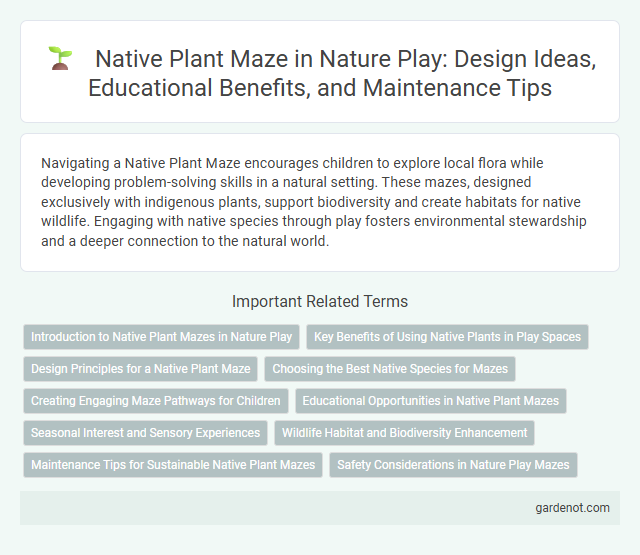Navigating a Native Plant Maze encourages children to explore local flora while developing problem-solving skills in a natural setting. These mazes, designed exclusively with indigenous plants, support biodiversity and create habitats for native wildlife. Engaging with native species through play fosters environmental stewardship and a deeper connection to the natural world.
Introduction to Native Plant Mazes in Nature Play
Native Plant Mazes integrate local flora to create interactive, educational landscapes that foster environmental awareness and sensory exploration in nature play. These mazes use native species to support biodiversity while encouraging children to engage physically and cognitively with regional ecosystems. Incorporating native plants enhances natural habitats, promotes sustainable play areas, and strengthens community connections to indigenous vegetation.
Key Benefits of Using Native Plants in Play Spaces
Native plant mazes enhance play spaces by supporting local biodiversity and providing habitat for pollinators like bees and butterflies. Using native species improves soil health and requires less water and maintenance, promoting sustainable play environments. These plants also offer children sensory-rich experiences through diverse textures, colors, and seasonal changes, fostering deeper connections with nature.
Design Principles for a Native Plant Maze
Design principles for a Native Plant Maze emphasize the use of indigenous flora to create an immersive, eco-friendly environment that supports local biodiversity and promotes environmental education. Paths are designed with natural materials and gentle curves to encourage exploration, sensory engagement, and a harmonious interaction with native ecosystems. Strategic plant placement ensures seasonal interest and habitat diversity, fostering a dynamic space that evolves naturally throughout the year.
Choosing the Best Native Species for Mazes
Selecting the best native species for a Native Plant Maze involves prioritizing plants that are well-adapted to the local climate, soil, and ecosystem to ensure sustainability and ease of maintenance. Species such as native grasses, wildflowers, and shrubs like switchgrass, purple coneflower, and chokeberry create natural barriers while supporting local wildlife and promoting biodiversity. Incorporating a mix of evergreen and deciduous plants enhances maze structure, seasonal interest, and ecological value in nature play environments.
Creating Engaging Maze Pathways for Children
Designing engaging maze pathways for children in a native plant maze incorporates varied textures, vibrant foliage, and tactile elements to stimulate sensory exploration. Utilizing native species such as milkweed and coneflowers creates dynamic visual interest while supporting local ecosystems and pollinators. Strategic maze layout encourages problem-solving and physical activity, fostering both environmental awareness and active play in natural settings.
Educational Opportunities in Native Plant Mazes
Native plant mazes offer rich educational opportunities by providing hands-on learning environments where students can explore local biodiversity and ecological relationships. These mazes serve as living classrooms that promote environmental stewardship through interactive lessons on native species, pollination, and habitat conservation. Engaging in native plant mazes enhances nature literacy and fosters a deeper connection to regional ecosystems among learners of all ages.
Seasonal Interest and Sensory Experiences
The Native Plant Maze features a diverse selection of indigenous flora that changes color, texture, and fragrance with each season, providing continuous sensory stimulation. Visitors engage their senses through the tactile leaves, aromatic blossoms, and vibrant seasonal blooms that create an immersive natural environment. The maze promotes environmental awareness by highlighting native species' adaptability and beauty throughout the year.
Wildlife Habitat and Biodiversity Enhancement
The Native Plant Maze serves as a dynamic wildlife habitat, supporting diverse species by providing native flora essential for food, shelter, and breeding grounds. This carefully curated plant selection promotes biodiversity enhancement by attracting pollinators, birds, and small mammals, fostering ecological balance within the environment. Integrating native vegetation in play areas strengthens ecosystem resilience and educates visitors on the importance of preserving local biodiversity.
Maintenance Tips for Sustainable Native Plant Mazes
Regular pruning and seasonal mulching promote healthy growth and prevent overgrowth in native plant mazes. Monitoring soil moisture and adjusting irrigation schedules ensure optimal hydration without water waste. Incorporating native pollinator-friendly plants supports biodiversity and long-term ecosystem balance within the maze.
Safety Considerations in Nature Play Mazes
Nature play mazes featuring native plants require careful safety considerations to ensure a secure environment for children. Selecting non-toxic, thorn-free native species minimizes injury risks while promoting ecological education. Clear pathways and regular maintenance prevent tripping hazards and overgrowth, enhancing overall safety in nature play spaces.
Native Plant Maze Infographic

 gardenot.com
gardenot.com